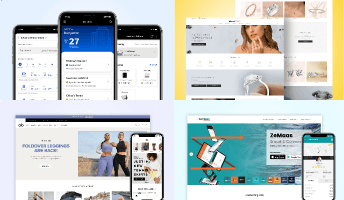Rejected from the App Store? Here’s Why & How to Fix It
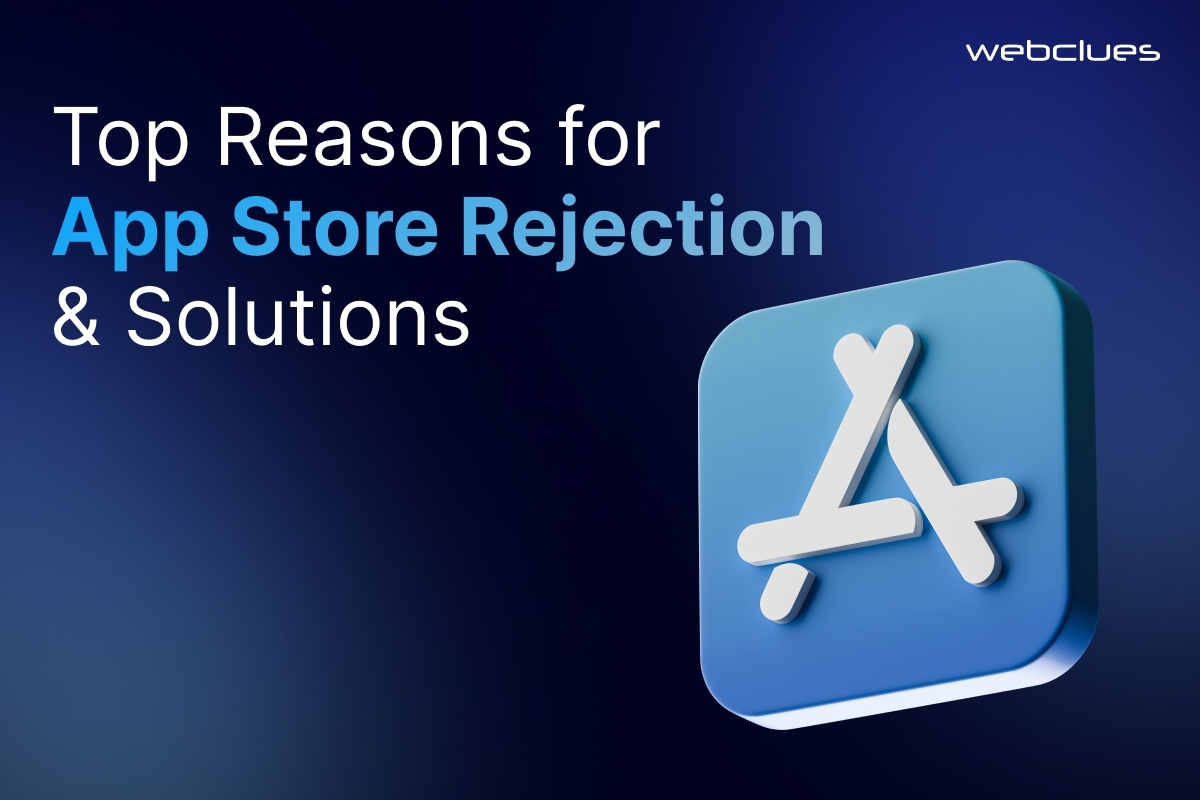
Getting an app rejected by the App Store is frustrating, especially after investing time and effort into development. Apple’s review process is strict, and even small issues—like minor bugs, missing privacy policies, or performance problems—can lead to rejection. Many developers run into the same roadblocks, whether it's guideline violations, crashes, or functionality concerns.
The key to getting approved is knowing exactly why rejections happen and fixing those issues before submitting the app again. Apple provides feedback, but understanding and acting on it correctly can be tricky. Ignoring the details or rushing a resubmission can lead to repeated rejections, costing both time and potential revenue.
That’s where expert guidance makes a difference. At WebClues Infotech, we are an experienced mobile app development company that helps businesses and developers build App Store-ready apps, handling everything from development to compliance checks. If you're struggling with an App Store rejection, this guide will walk you through the common reasons and practical steps to fix them—so you can get your app live without unnecessary delays.
Common Reasons for App Store Rejection
Apple’s review process is strict, and even small mistakes can lead to rejection. Here are some of the most common reasons why apps don’t make it through and what developers can do to fix them.
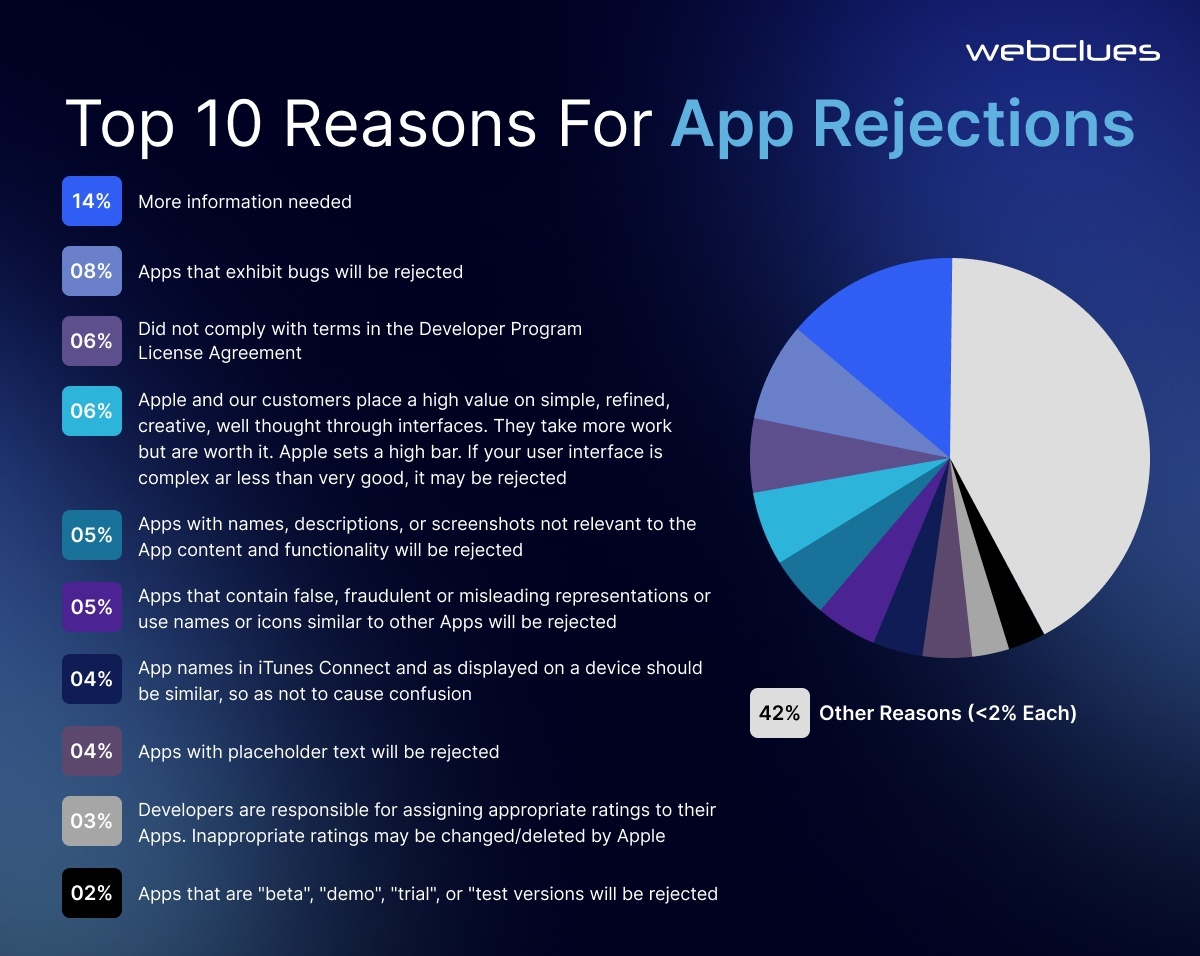
Crashes and Bugs
If your app crashes during Apple’s review, it’s an automatic rejection. Even a single crash or freeze can be enough to stop your app from going live. Apple expects apps to be stable, well-tested, and free of obvious issues before submission.
How to Fix It:
- Run thorough testing on different iOS devices and versions.
- Use tools like Xcode Instruments and TestFlight to catch crashes before submitting.
- Fix memory leaks, broken API calls, and unhandled errors.
Poor Performance
Even if your app doesn’t crash, it can still be rejected if it lags, drains the battery too quickly, or takes too long to load. Apple prioritizes smooth user experiences, so apps that feel slow or unresponsive often don’t make the cut.
How to Fix It:
- Optimize animations, background processes, and memory usage.
- Reduce app startup time and test performance under different network conditions.
- Make sure your app runs smoothly on older iPhones, not just the latest models.
Privacy Policy Violations
Apple takes user privacy seriously. If your app collects data but doesn’t have a clear privacy policy, it will be rejected. The same applies if your app requests permissions (like location or camera access) without explaining why.
How to Fix It:
- Add a detailed privacy policy to your App Store listing.
- If your app collects data, explain how it’s used in the privacy policy.
- Make sure you request only the permissions your app actually needs.
Broken Links
Apple checks every link in your app. If any of them lead to a 404 page, outdated content, or an inactive website, your app will be rejected. This includes support links, terms of service, and social media pages.
How to Fix It:
- Double-check all external and in-app links before submitting.
- Make sure support and contact links are live and lead to the correct pages.
- If your app has a login or registration page, test it thoroughly to avoid broken redirects.
Inadequate Content or Functionality
Apps that don’t offer much in terms of features or content often don’t make it past Apple’s review. If the app feels too basic, lacks real user value, or is just a web page wrapped in an app shell, it’s likely to be rejected.
How to Fix It:
- Add useful features that make the app more than just a website in an app wrapper.
- Make sure there’s enough interactive content for users to engage with.
- If the app is too basic, consider adding more functionality before resubmitting.
Detailed Solutions to Prevent Rejection
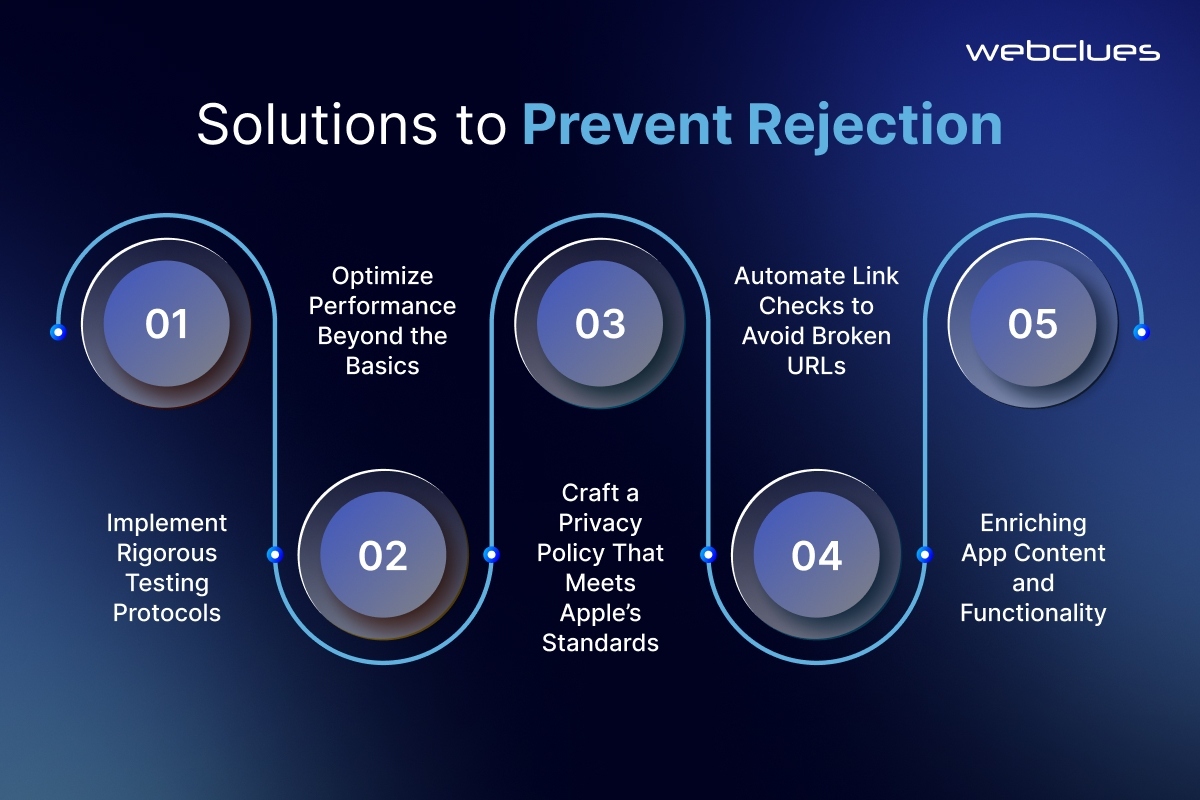
Once you understand why Apple rejects apps, the next step is to make sure your app is bulletproof before submission. Here’s how to prevent rejection from happening in the first place, rather than fixing issues after the fact.
Implement Rigorous Testing Protocols
A crash-free app isn’t just about fixing bugs—it’s about anticipating them. Apple tests apps in different scenarios, so you need to do the same before submitting.
Key Areas to Focus on:
Device & OS Compatibility
- Test on multiple iPhone and iPad models (including older versions).
- Check compatibility with different iOS versions, including the latest beta releases.
Automated & Manual Testing
- Use XCTest and Appium for automated testing to catch failures before they reach Apple’s reviewers.
- Manually test critical user flows (onboarding, checkout, profile setup) to catch edge cases.
Edge Case Testing
- Simulate bad network conditions (3G, airplane mode, slow WiFi) to check how the app behaves.
- Rotate the screen, switch between apps, and test with low battery to find unexpected crashes.
Beta Testing
- Use TestFlight to gather real-world feedback before submission.
- Collect crash reports from testers and address the most common issues.
Crash Monitoring
- Integrate tools like Firebase Crashlytics to detect and fix post-launch errors early.
Source: MOBILOUD
Optimize Performance Beyond the Basics
Performance isn’t just about loading speeds—it’s about consistency and efficiency. Apple checks how your app behaves under different conditions, including battery usage and memory consumption.
Best Practices for App Performance Optimization:
Reduce Startup Time
- Apple reviewers reject apps that take too long to launch. Optimize initialization logic and delay non-essential API calls.
- Load assets asynchronously and prioritize above-the-fold content.
Efficient Rendering
- Avoid unnecessary UI re-renders and optimize animations. Use Core Animation for fluid UI interactions.
- Profile app performance using Xcode’s Instruments tool.
Background Processing
- Apple rejects apps that drain battery due to poorly optimized background tasks.
- Use Background Modes sparingly and release resources efficiently.
- Terminate background tasks when they are no longer needed.
Memory Management
- Optimize how your app handles large assets (videos, images, or JSON payloads) to prevent crashes due to memory overload.
- Avoid memory leaks by properly deallocating objects when they’re no longer in use.
Source: MOBILOUD
Craft a Privacy Policy That Meets Apple’s Standards
Apple’s privacy rules are getting stricter every year. Even if you include a privacy policy, vague or incomplete information can still lead to rejection.
Steps to Meet Apple’s Privacy Requirements:
Be Transparent
- Clearly explain what data you collect, how it’s used, and whether it’s shared with third parties.
- Be explicit about tracking, analytics, and third-party SDKs.
Match App Store Metadata
- The privacy details listed in the App Store must match your app's actual behavior.
- If your app tracks user activity, you must declare it in App Store Connect.
Minimal Data Collection
- Apple is strict about unnecessary permissions. If your app doesn’t need location data or microphone access, don’t request it.
Link to a Live Privacy Policy
- The link to your privacy policy must be functional and should be easily accessible inside the app itself.
Source: MOBILOUD
Automate Link Checks to Avoid Broken URLs
Dead links are an easy rejection trigger that many developers overlook. Apple reviewers manually check every external and in-app link. If even one leads to a 404 error, your app won’t pass.
How to Proactively Fix This:
Automate Link Testing
- Use tools like Screaming Frog SEO Spider or custom scripts to periodically check for broken links.
Use Fallback Pages
- If an external service goes down, redirect users to a fallback page instead of displaying a broken link.
Maintain Support Links
- Apple reviewers check support links to ensure users can reach out for help.
- Make sure your help desk, privacy policy, and contact pages are active.
Source: MOBILOUD
Enriching App Content and Functionality
Apple doesn’t just check for bugs and performance issues—it also evaluates whether your app provides real value. Apps that feel too basic, lack interactivity or don’t offer meaningful features often get rejected.
How to Meet Apple’s Standards:
Move Beyond a Basic App Shell
- If your app is just a web page wrapped in an app, Apple will likely reject it.
- Add mobile-native features such as push notifications, offline access, or native UI elements to create a better experience.
Improve User Engagement
- Apps that offer more interactive elements tend to get approved faster. Consider adding:
- User profiles
-Personalized content recommendations
-Gamification elements (badges, leaderboards, progress tracking)
-AI-driven content filtering
Follow Apple’s UI/UX Guidelines
- Apple favors apps that feel native to iOS. Use SF Symbols, standard navigation patterns, and responsive layouts.
Keep Content Fresh
- Apps that seem stale or inactive can get flagged. If your app is content-heavy (news, media, or social), plan for regular updates.
- Implement dynamic content updates so that users always find something new.
Source: ADAPTY
The App Resubmission Process
Understanding the Rejection Notice
Apple provides a detailed rejection notice through App Store Connect. It’s essential to read and analyze it carefully before making changes. Look for:
- The specific guideline your app violated.
- A detailed explanation of the issue.
- Screenshots or testing scenarios Apple reviewers used to find the problem.
Implementing Required Changes
Once you understand the issue, fix it thoroughly to avoid another rejection. Steps include:
- Bug Fixes & Performance Adjustments – Address crashes, memory leaks, or UI inconsistencies Apple highlighted.
- Policy & Compliance Fixes – Update privacy settings, permissions, or disclosures as required.
- Testing & QA – Re-run tests on all targeted iOS versions to confirm fixes.
Preparing for Resubmission
Before submitting again, make sure your app is 100% compliant with Apple’s guidelines. Use this checklist:
- All rejection issues are fixed.
- Privacy Policy & Permissions are correct.
- No crashes or performance issues remain.
- Tested on multiple iOS devices and OS versions.
- Support links and App Store metadata are correct.
Best Practices for Future Submissions
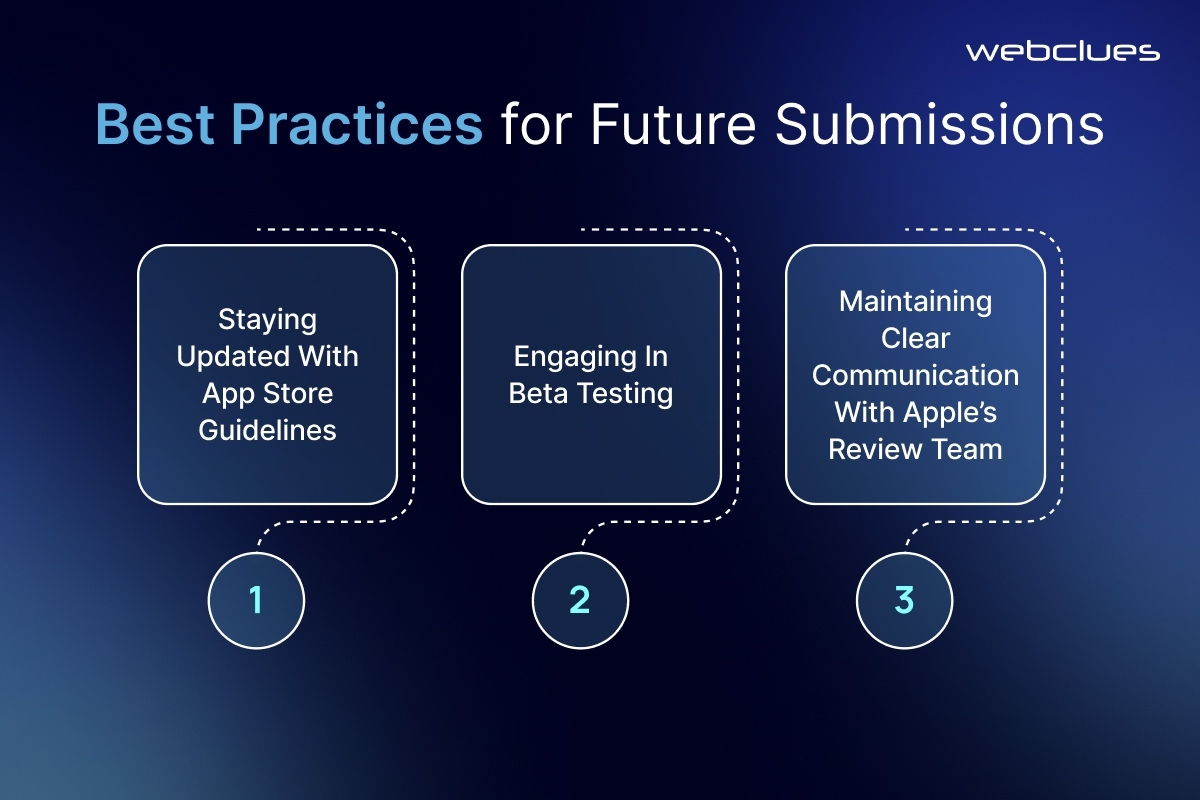
Staying Updated with App Store Guidelines
Apple frequently updates its guidelines, and failing to follow the latest changes can result in rejection.
- Regularly review Apple’s App Store Review Guidelines to stay informed about policy updates.
- Follow Apple’s developer news and community discussions to anticipate upcoming changes.
- Subscribe to Apple’s announcements to track security, privacy, and policy updates.
Engaging in Beta Testing
Before submitting, beta testing helps catch bugs, performance issues, and usability problems that Apple’s reviewers may flag.
- Use TestFlight to conduct structured beta testing.
- Gather user feedback and fix usability concerns before submission.
- Test on different devices and network conditions to avoid unexpected rejection.
Maintaining Clear Communication with Apple’s Review Team
Clear and professional communication with Apple’s review team can help resolve issues faster if your app faces rejection.
- Use App Store Connect Resolution Center to respond to Apple’s feedback.
- If Apple requests changes, ask for clarification if needed before making adjustments.
- If a rejection seems unclear or unfair, politely request additional details or an appeal.
Final Thoughts
Getting through Apple’s approval process takes effort, but rejections are avoidable with the right approach. The key is thorough testing, well-structured privacy policies, optimized performance, and meaningful app functionality. Addressing potential issues before submission can save time and frustration.
If your app has been rejected or you want to make sure it meets Apple’s standards from the start, WebClues Infotech can help. Our team specializes in iOS app development, testing, and compliance to optimize the submission process.
Need help with your app submission? Contact WebClues Infotech today.
Build Your Agile Team
Hire Skilled Developer From Us
Develop iOS apps designed for App Store success with WebClues Infotech.
Avoid the frustration of rejection with expert-driven app development. We handle UI/UX, coding, compliance, and testing to make your app launch-ready. Build smarter with WebClues —where development meets approval. Let’s talk!
Contact Today!Our Recent Blogs
Sharing knowledge helps us grow, stay motivated and stay on-track with frontier technological and design concepts. Developers and business innovators, customers and employees - our events are all about you.
Contact
Information
India
Ahmedabad
1007-1010, Signature-1,
S.G.Highway, Makarba,
Ahmedabad, Gujarat - 380051
Rajkot
1308 - The Spire, 150 Feet Ring Rd,
Manharpura 1, Madhapar,
Rajkot, Gujarat - 360007
UAE
Dubai
Dubai Silicon Oasis, DDP,
Building A1, Dubai, UAE
USA
Atlanta
6851 Roswell Rd 2nd Floor,
Atlanta, GA, USA 30328
New Jersey
513 Baldwin Ave, Jersey City,
NJ 07306, USA
California
4701 Patrick Henry Dr. Building
26 Santa Clara, California 95054
Australia
Queensland
120 Highgate Street,
Coopers Plains,
Brisbane, Queensland 4108
UK
London
85 Great Portland Street, First
Floor, London, W1W 7LT
Canada
Burlington
5096 South Service Rd,
ON Burlington, L7l 4X4
Let’s Transform Your Idea into
Reality. Get in Touch

